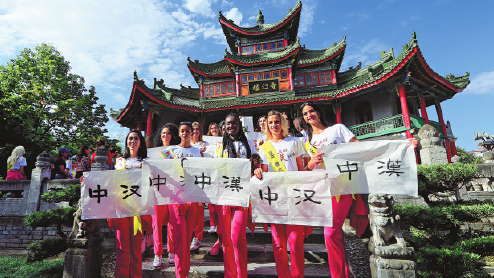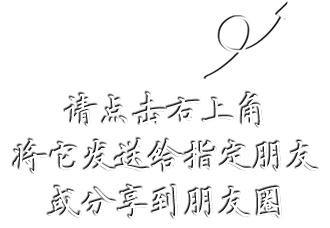
Tourists show the calligraphy of "Hanzhong" in front of Wangjianglou, a scenic spot in the city.
In 138 BC, when envoy Zhang Qian struck out on his expedition westwards on order of the Emperor Liu Che during the Western Han Dynasty (206 BCAD 24), he didn't realize just how difficult the journey would be. His orders were to seek a diplomatic alliance with Darouzhi, an untapped country as far as the edge of heaven and persuade its leader to help in the fight against Xiongnu, a powerful nomadic tribal group on the border of the Han territory.
Despite being captured twice and held in custody for a total of 11 years in the northern kingdom of Chanyu, a branch of Xiongnu, Zhang did not give up. He escaped with his entourage and headed west again until he reached Darouzhi, and then returned to Chang'an in 126 BC with records of geography, local conditions and customs.
"Zhang Qian was a very responsible and competent envoy. He demonstrated a pioneering spirit, courage of exploration and the determination to serve the country, which are of key significance in the modern era, especially under the Belt and Road Initiative," said Zhang Lijun, decedent of Zhang Qian, who lived in Chenggu county in Hanzhong. The county is home to the Memorial Hall of Zhang Qian and his tomb, which were included on the World Cultural Heritage List in 2014.
"I feel proud to be a descendent of Zhang Qian, who played a vital role in the country's opening-up and innovation in ancient times. He is a true pioneer of the Silk Road," he said.
"Seen as a hometown for Han people, Hanzhong has rich cultural and historical legacies. We hope more people will visit Hanzhong to learn about Han characters, the language and customs," he added.
The city of Hanzhong, from which the Han ethnic group gets its name, is a cradle for China's Han culture and the Han Dynasty (206 BC-AD 220).
The city's rise started when Liu Bang, who was named the Han king by the warlord Xiang Yu after the Hongmen banquet, made Hanzhong, called Nanzheng in ancient times, the capital of his kingdom in 206 BC.
Liu viewed Hanzhong as a key spot for rallying forces, where he took several months to rebuild troops, recruit talented military soldiers including Han Xin and contend for supremacy. Hanzhong is vital to Liu's revival and the advancement of Chinese history as it helped him to quickly recuperate and build up strength to fight with Xiang. After five years' preparation, Liu finally defeated Xiang, united the country and named his dynasty Han.
The magnanimity, tolerance and prosperity of Liu's kingdom can still be seen today at the ancient Hantai, the palace site of the Han king at the Hanzhong museum.
Divided into three steps, the ancient Hantai is 7 meters high and faces south. It is a site with a typical Qin and Han court pattern built by man-made rammed earth. The museum has ancient plank roads built along the face of a cliff, historical relics of the Hanzhong and the Han Dynasty, cultural relics unearthed in Hanzhong, ancient calligraphy and paintings and collections of religious statues.
Another must-see historical relic in Hanzhong is the Tomb of Cai Lun, a eunuch who served at court during the Eastern Han Dynasty (25-220) and used his position to perfect the art of papermaking. Cai is regarded as the inventor of ancient paper and the papermaking process.
The tomb, located in the village of Longting, 10 kilometers east of Yangxian county, is the manor and burial place of Cai. The 52-square-kilometer site boasts traditional Chinese buildings, ancient gardens, cultural relics and stone carvings. Surrounded by ancient cypresses and bamboo forests, the temple offers a serene site for people to pay tribute to the great inventor.
Wuhou Temple in Mianxian county is another national cultural relic in Hanzhong. It is the only memorial temple that the emperor Liu Shan had built for Zhuge Liang, a renowned military strategist during the Three Kingdoms period (220-280).
After more than 1,700 years, the temple is rich in cultural relics, with plaques, steles, stones and many ancient trees. It integrates ancient architecture, gardens, literature, art, calligraphy, painting, sculpture and color painting.
Guo Manman, chief expert at the temple, said the site has become an education base for students across the country.
"Culture and history rooted in the Three Kingdoms period is very profound and I want to give opinions that are still relevant in the modern era."
wangjinhui@chinadaily.com.cn

